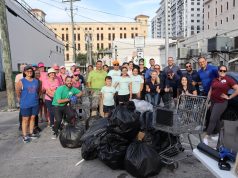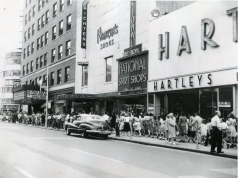HistoryMiami Museum hosted an event last weekend that expressed the distinct cultural traditions that come together to form “Miami culture.”
Not even overcast skies and light showers Saturday could stop CultureFest 305 from happening for the third year. This year’s lineup consisted of performances and demonstrations from nine different countries, including Brazil, Venezuela, Haiti, Cuba, and, surprisingly, Ireland.
“We don’t have a huge Irish population, but we have exceptional traditional Irish artists,” said festival creator Vanessa Navarro Maza. “James Kelly, who is the fiddler that we will be featuring here today, is a huge deal in Ireland, and he lives here in Miami.”
The Dublin-born fiddler was accompanied by American instrumentalist Paul Groff. Kelly said he has lived in Miami for over 30 years and has performed for HistoryMiami about six times.
“[Sharing culture] is an opportunity to connect with people, to tell people something about your own background, and an opportunity to expose them to your history,” he said.
Despite temperamental weather, a crowd emerged to watch Kelly and Groff play while four dancers from the Breffni Academy did traditional Irish dances in colorful dresses and with curled hair.
“The Breffni Academy has been teaching Irish dance for over 20 years and they have dancers that they train here, who are then champions in Ireland,” said Navarro Maza.
Seminole art was also featured. Pedro Zepeda creates traditional art including wood-based work and basket weaving. During the event, he spent four hours carving a canoe alongside his son, Kyle Zepeda.
“Traditional arts really are vessels of cultural knowledge. It’s not just an object, there’s a lot of language and stories and other socio knowledge that goes along with making these things,” he said.
The creator of the festival, Navarro Maza, is also the curator of Folklife.
According to the HistoryMiami website, Folklife, founded in 1986, is a division of the museum. It’s goal is to document and support the region’s traditions and cultures. Folklife, as described by Navarro Maza, refers to cultural practices that tie individuals to their folk group. This extends to family, ethnic, and religious groups.
“Miami Folklife is amazing. We live in a community where we’ve had huge waves of immigration. We have these large communities that come here and are able to take root and really continue their cultural practices and keep that sense of community,” said Navarro Maza.
HistoryMiami Museum itself was created to inspire learning and engagement from the community about all the different cultures that exist in Miami. According to their website, in 2011 they became part of the Smithsonian Institution Affiliations Program.
“This affiliation helps you if you want to produce exhibits or collections and need to borrow items. It opens up pathways, and they only do it for museums that are accredited and fits their standards,” said the executive director of the museum, Jorge Zamanillo.
































